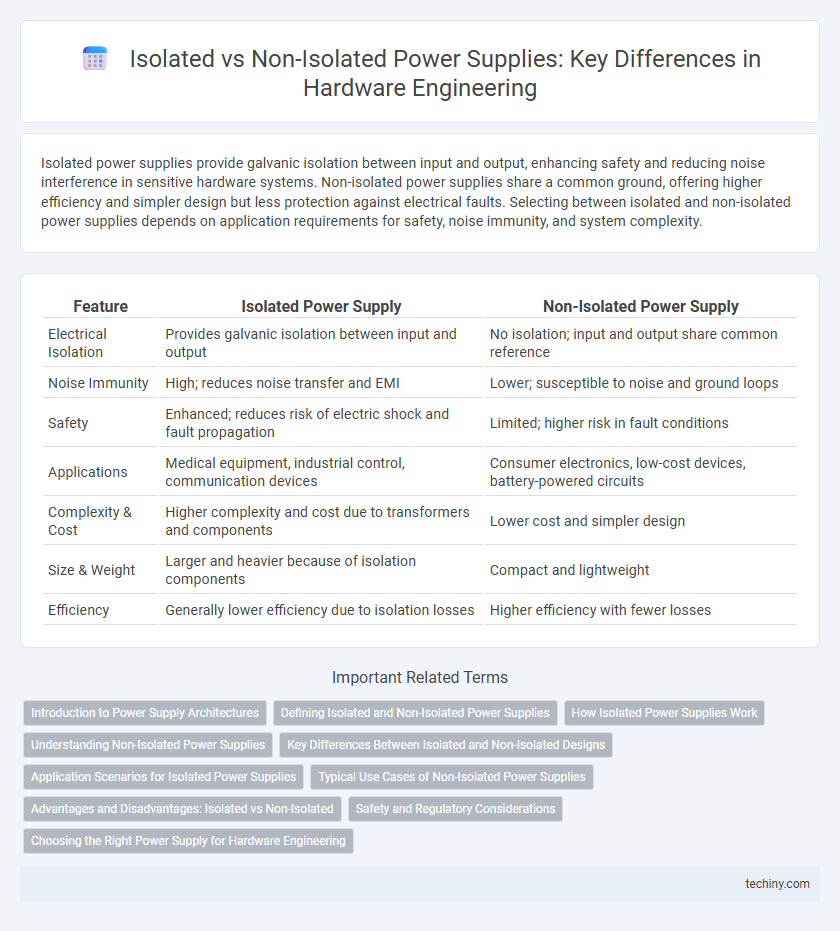Isolated power supplies provide galvanic isolation between input and output, enhancing safety and reducing noise interference in sensitive hardware systems. Non-isolated power supplies share a common ground, offering higher efficiency and simpler design but less protection against electrical faults. Selecting between isolated and non-isolated power supplies depends on application requirements for safety, noise immunity, and system complexity.
Table of Comparison
| Feature | Isolated Power Supply | Non-Isolated Power Supply |
|---|---|---|
| Electrical Isolation | Provides galvanic isolation between input and output | No isolation; input and output share common reference |
| Noise Immunity | High; reduces noise transfer and EMI | Lower; susceptible to noise and ground loops |
| Safety | Enhanced; reduces risk of electric shock and fault propagation | Limited; higher risk in fault conditions |
| Applications | Medical equipment, industrial control, communication devices | Consumer electronics, low-cost devices, battery-powered circuits |
| Complexity & Cost | Higher complexity and cost due to transformers and components | Lower cost and simpler design |
| Size & Weight | Larger and heavier because of isolation components | Compact and lightweight |
| Efficiency | Generally lower efficiency due to isolation losses | Higher efficiency with fewer losses |
Introduction to Power Supply Architectures
Isolated power supplies use transformers or optocouplers to separate input and output circuits, ensuring safety and noise reduction in sensitive hardware engineering applications. Non-isolated power supplies share a common ground between input and output, offering simpler design and higher efficiency but less protection against electrical faults. Choosing the appropriate power supply architecture depends on the specific requirements for isolation, safety, and electromagnetic interference in the hardware system.
Defining Isolated and Non-Isolated Power Supplies
Isolated power supplies provide electrical separation between input and output circuits through transformers, ensuring no direct conductive path and enhancing safety and noise immunity in sensitive hardware engineering applications. Non-isolated power supplies share a common ground between input and output, offering simpler design and higher efficiency but limited protection from electrical interference and potential ground loops. Understanding the difference aids in selecting the appropriate power supply type for circuits requiring isolation in complex electronic systems.
How Isolated Power Supplies Work
Isolated power supplies operate by separating the input and output circuits through a transformer or optocoupler, preventing direct electrical connection and enhancing safety by minimizing noise interference and ground loop issues. They use magnetic coupling to transfer energy while maintaining electrical isolation, which is essential in sensitive electronic applications and medical equipment. This isolation ensures consistent voltage regulation and protection against voltage spikes from the primary side to the secondary load.
Understanding Non-Isolated Power Supplies
Non-isolated power supplies share a common ground between the input and output, providing a direct electrical connection that simplifies circuit design and reduces cost. These power supplies are ideal for applications where electrical isolation is not critical, such as in low-voltage, low-noise environments or internal device circuits. Understanding the lack of galvanic isolation helps engineers assess safety risks and interference susceptibility when selecting non-isolated power supplies for hardware design.
Key Differences Between Isolated and Non-Isolated Designs
Isolated power supplies feature galvanic isolation between input and output, enhancing safety and minimizing noise interference, making them ideal for sensitive electronic equipment and medical devices. Non-isolated power supplies share a common ground between input and output, resulting in simpler circuit design, lower cost, and higher efficiency but reduced protection against electrical faults. Key differences include isolation presence, safety standards compliance, noise immunity, and application suitability, influencing design choice in hardware engineering projects.
Application Scenarios for Isolated Power Supplies
Isolated power supplies are essential in medical devices, industrial automation, and communication systems where electrical isolation enhances safety and reduces noise interference. They prevent ground loops and protect sensitive circuits from high voltage surges, making them ideal for critical applications requiring reliable signal integrity. In contrast, non-isolated power supplies are typically used in cost-sensitive or space-constrained environments where isolation is not a primary concern.
Typical Use Cases of Non-Isolated Power Supplies
Non-isolated power supplies are commonly used in applications where the input and output share a common ground, such as in low-voltage DC-DC converters for embedded systems and battery-powered devices. Typical use cases include powering microcontrollers, sensors, and communication modules within a single circuit board, where electrical isolation is not critical. These power supplies offer simpler design, higher efficiency, and lower cost compared to isolated power supplies, making them ideal for cost-sensitive, compact hardware engineering projects.
Advantages and Disadvantages: Isolated vs Non-Isolated
Isolated power supplies provide enhanced safety and noise reduction by electrically separating input and output, making them ideal for sensitive electronics and medical devices. Non-isolated power supplies offer higher efficiency and lower cost but lack galvanic isolation, increasing the risk of ground loops and potential interference in critical applications. The choice depends on balancing isolation benefits against efficiency and cost constraints in hardware design.
Safety and Regulatory Considerations
Isolated power supplies provide galvanic isolation between input and output, significantly reducing the risk of electric shock and enhancing user safety in hardware engineering applications. They comply with stringent regulatory standards such as UL, IEC, and EN for medical and industrial equipment by preventing ground loops and minimizing electromagnetic interference. Non-isolated power supplies lack this isolation, requiring additional protective measures to meet safety regulations and increasing the complexity of compliance in sensitive or high-voltage environments.
Choosing the Right Power Supply for Hardware Engineering
Choosing the right power supply in hardware engineering depends on isolation requirements, voltage levels, and safety standards. Isolated power supplies provide galvanic isolation, reducing noise interference and protecting sensitive components, making them ideal for medical devices and industrial control systems. Non-isolated power supplies are more efficient and compact but lack isolation, suitable for applications where cost and size are critical, such as consumer electronics.
Isolated Power Supply vs Non-Isolated Power Supply Infographic

 techiny.com
techiny.com